![]()
![]()
![]()
Use LEFT and RIGHT arrow keys to navigate between flashcards;
Use UP and DOWN arrow keys to flip the card;
H to show hint;
A reads text to speech;
10 Cards in this Set
- Front
- Back
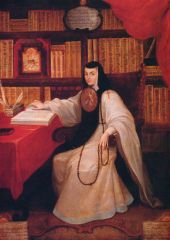
#99 Portrait of Sor Juana Inés de la Cruz Miguel Cabrera 1750 C.E. _____________________ Content: This is a portrait of Sor Juana, a Catholic nun and sister of the Jeronimite order in New Spain (Mexico). She is sitting in a library, poised to write in the open book directly in front of her as she looks off slightly past the viewer into the distance. A library setting surrounds her, with shelved full of volumes, scientific equipment, and red curtains. Sor Juana wears her nun's habit, a large nun's badge beneath her chin, and a long, draping rosary. _____________________ Style: The scene is documented realistically and styled very similarly to the portrait of St. Jerome and other portraits of famous intellectuals at the time. The red curtains behind her, for example, were common in elite portraits and represented a higher status. All her religious garb was meant to convey the deep connection she had with her faith, while her surroundings communicate her love for learning. |
Context: Once a lady-in-waiting for the Viceroy (stand-in royalty) of New Spain, Sor Juana eventually became a famous Mexican nun and intellectual, often called "The Tenth Muse". She wrote plays and poetry, engaged in debate with other philosophers and scientists of the time (including one Ecclesiastical dispute), and was considered one of the first feminists. Instead of marrying (as marriage happened very young at this time), Sor Juana decided to pursue her intellectual passions at in a Carmelite convent before converting to the Jeroimite order, which had more freedoms. Despite being a nun, she still defended her rights as a woman and eventually drew concern from the Church about her intelligence, vocality, and advocacy. After a while, the Church forced Sor Juana to sell her library and give up her intellectual pursuits as well as her musical and scientific instruments. She was made to sign a document declaring she would cease her education and relinquish her intelligence. The thought that she might have been willing to do this is challenged by the fact she signed the contract with her own blood. From that day on, Sor Juana served as a nurse in an infirmary until she contracted a disease from an epidemic and passed away. The artist, Cabrera, most likely pictured Sor Juana in this way to give tribute to her religious and intellectual purposes. It is also thought that he modeled her features (as this was painted after her death) after Sor Juana's own self-portraits. |
|
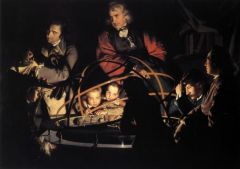
#100 A Philosopher Giving a Lecture at the Orrey Joseph Wright of Derby 1763 - 1765 C.E. _____________________ Content: The painting shows a groups of people, including two small children and a veiled woman, gathered around a device called an Orrey to hear a speaker. The man in the center is the philosopher delivering the lecture and the man to his left is taking notes. ____________________________________ Style: The noticeable feature of this painting in the contrast between the dark background and the dramatic lighting coming from the center of the Orrey (meant to show the glory of education and learning in much the same way as was done to represent the glory of God in many Renaissance paintings). The light illuminates the people's faces and how transfixed and awed their expressions are. The philosopher is placed prominently in the center and dressed in red, symbolizing his importance and also drawing attention within the piece. The perspective of the painting, as well as the people with their backs turned to the viewer, make it seem as if the viewer is part of the scene and witnessing the lecture in the very same way. |
Context: To start, an Orrey was a machanical, clockwork device that would be calibrated to recreate the movements of the plants in the solar system. The light shown in the painting may have well been a lantern placed in the center of the device to imitate the light and function of the sun. The artist used this painting, and its many stylistic features, to communicate the scientific information that was becoming available to the upper class on a global scale and the public's fascinating with knowing more about the world. This movement was spurred by the Enlightenment period, which challenged myths and preconceived ways of thinking. Instead, everyone was encouraged to find new ways of thinking and share with the public through new forms of education. This painting also suggests that even women and children were beginning to grab the opportunity at higher education, adding to the population of intelligent people. |
|
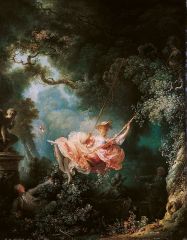
#101 The Swing Jean-Honoré Fragonard 1767 C.E. _____________________ Content: This painting is one of a fine lady being pushed on a large, ornate swing by a man further back, The scene is set in an dense and wild garden, with flowers and little cupid statues surrounding the scene (one with its hand in a "shush" position over its mouth). There is another man lying on the bushes in front of the swing (presumably looking up the lady's skirt as she swings). The lady herself is dressed in an elaborate pink dress and seen kicking off one of her shoes. ___________________________________ Style: The style is the epitome of Rococo, a french design of painting that was all about lightheartedness in both subject and technique. The painting was made with high regard to realism and naturalism (especially in the foliage) but also with intentional use of soft colors and ornate details (with the layers and ruffles of the dress fabric). There is also strong use of implied line, with all the eyes in the painting (even those of the statues) being directed towards the woman as she becomes the focal point of the piece. She is also clothed in the lightest colors and bathed in sunlight, again casting her as the main subject. The scene is also very pastoral with an emphasis on the background and natural surroundings as being very tranquil and also secretive. |
Context: This was painted during a time when the aristocracies of nations (especially France) lived better than most of the populace. The wealthy and lavish way of living that those nobles sustained in enraptured in the costume-like dress of the women and the frivolity of the subject matter. During this time, women were also major patrons of the arts, mainly paintings that held scandalously sexual undertones. This kind of art serves as the wealthy people's escape from the real issues that France was facing and the outrage of the people at the aristocrat's superior lifestyle. Art became selfishly exclusive to the rich people and served as an attractive way for nobles to see themselves represented. If was this kind of pattern, of course, that later provoke the rise of the French Revolution and the overthrow of the aristocrats. |
|

#102 Monticello Virginia, U.S. (architect) Thomas Jefferson 1768 - 1809 C.E. _____________________ Content: This served as Jefferson's private residence, as was designed as a livable home space. _________________________________ Style: Neoclassicism The colonnades, pediment, Persian windows, and dome all speak to classic European architecture. The interior is similar to a basilica plan, along with the Roman tradition of a large meeting area topped with a dome. The transept of the house intersects like the gothic churches seen in Europe. The steps leading to the front entrance are also similar to ancient Etruscan temples and most of the outdoor gardens were styled in a French imitation. |
Context: Thomas Jefferson (as a father of the American Revolution) became fascinated with classical antiquity during his many travels to Europe as an ambassador. He brought back his inspiration from several classical civilizations and moved to re-establish them in the young country of American through Neoclassicism, a movement seeking to reinvent classical ideas. Jefferson even moved to have Neoclassicism become that national architecture of America, and emulated that wish in the design of his own home. The ideas Jefferson brought did, in fact, resonate with the United States. Many classical myths and legends often illustrated the struggle against higher powers, similar to America's recent struggle to become independent from England and many of the old world cultures valued civic virtue and democratic involvement, both of which became foundations for America's political formation. |
|
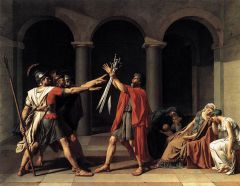
#103 The Oath of the Horatti Jacques-Louis David 1784 C.E. _____________________ Content: The painting, depicting a Roman myth, shows three brothers swearing on their swords held aloft by their father, while women sit to the right of the composition and grieve. All the figures are placed in an unidentifiable, columned hall. _________________________________ Style: Neoclassicism With a neoclassicist style and intention, this piece is both simplistic, symbolic, and a rejection of the coveted style of Rococo that was being embraced at the time. The painting is organized and structured. The male figures are constructed with geometric shapes; the females, with organic ones. |
Context: The legend that promoted the subject matter of this piece was about a conflict between Rome and the neighboring city of Alba. Instead of declaring war on each other, each city instead sent three representative to settle the dispute in combat. Rome chose the three brothers of the Horatti and the scene shows the oath they took before departing for the battle to defend Rome at all costs. It was typical that the fights like this one were only finished when one man remained standing. This explains why the women, most likely family relations or wives, are grieving for their husbands. It was likely they wouldn't return. The legend of the Horatti, like many classical stories, held a moral that was valued in Roman culture: sacrifice for the defense of your city (or nation) is a noble cause. At the time David painting this piece, France was on the verge of its Revolution and the end of the monarchy. As the artist was friends with Robespierre, a major mind in the development of the French Revolution, David no doubt picked up on the independence ideals that were resurfacing all over the world (for example, In America, with the American Revolution) and within that inner circle of Revolutionary thinkers. The result may have been the creation of this painting itself, and the important theme of self sacrifice for a greater good that it carries, the same motivation for the common people in the French Revolution. |
|
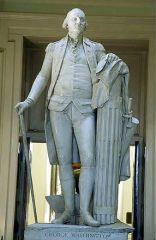
#104 George Washington Jean-Antoine Houdon 1788 - 1792 C.E. _____________________ Content: This is a marble sculpture depicting George Washington. _________________________________ Style: Neoclassicism The choice of white marble is an indicator of the artist's neoclassicist style, as is the contraposto stance in which he places Washington, and the symbolic details that are sculpted along with the form. Washington is shown in street clothes, rather than his military uniform for which he was famous for and has a "fatherly" expression. He is leaning on a sculpted bundle of 13 rods, a fasces, which symbolizes power and authority, as does the sword he holds. The artist's choice not to have the sword in hand, however, speaks to Washington's history of having given up his military and presidential careers in order to let the young country of America grow. |
Context: This sculpture was made after the American Revolution, at a time when it was popular to commission the depiction of war heroes. The statue was ordered by the Virginia Governor, but sculpted by a French artist. There were two reasons for this, one being that there were no practiced American sculptors, the other being that the French people idealized the fore-fathers of America, like Washington, who had rebelled against a monarchy. The way Washington was styled was also inspired by his choice to retire from his military position and precedency in order to pursue farming instead and allow his country to develop without a constant, potentially corrupt, political/military figure. |
|
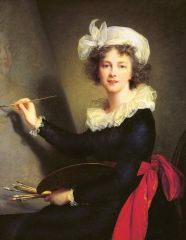
#105 Self-Portrait Elisabeth Louise Vigée Le Brun 1790 C.E. _____________________ Content: This is a self-portrait of Elisabeth shown in the act of painting, with brushes and a pallet in hand, while wearing a black dress with white ruffles, a dark red sash, and a white headscarf. _________________________________ Style: Naturalism This painting is a return to the more naturalistic ideals that appeared in the Renaissance. Elisabeth is shown looking straight at the viewer and in a natural, active position. There is no focus on the portrait she is shown painting, and it is monochromatically blended into the background. Instead, Elisabeth herself holds all the attention of the piece, especially with the addition of the contrasting red sash that she is wearing. |
Context: This artist was once highly famous for her portraiture in Europe, she even painted for Marie Antoinette. But, even though she painted for royalty, her paintings did not utilize many Rococo styles. Instead, Elisabeth embraced a Rousseau philosophy that celebrated any natural beauty that could be found in a growing industrial world. This piece also represents the emergence of the artist as an individual, as this was a self-portrait rather than a commissioned work and featured the artist instead of a posed, royal subject. Elisabeth was also the first women to be accepted into the Royal Academy of Art and Sculpture in France, which was dissolved during the French Revolution. Unfortunately, she was not invited back after the reconstruction of the institute (because she was a woman and because she was the first to buck the traditional cannon of portraiture). Instead of letting the design halt or alter her work, Elisabeth continued her art outside of any systematic art academy and still succeeded in portraying her naturalistic and individual beliefs. |
|
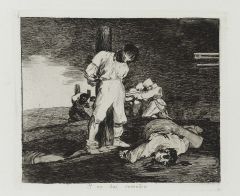
#106 Y no hai remedio (And There’s Nothing to Be Done), from Los Desastres de la Guerra (The Disasters of War), plate 15 Francisco de Goya 1810 - 1823 C.E. (not published until 1863) _____________________ Content: This was a single print within a series that documented the destruction the Peninsular War (1808-1814) caused on Spain. This print (#15) shows a man tied up in front of a firing squad, surrounded by the bodies of those already shot. _________________________________ Style: Romanticism Made to communicate a certain message and historically depict a strong subject matter, this print uses the characteristics of romanticism, like potent subject and an uncensored style to fully achieve that purpose. This print in particular also uses grotesque imagery, the depiction of brutal military action, and raw human emotion (also seen in the title) to harness the true communication of the art. The piece is also strategically structured and compositional, with the use of directed line to lead the eye to the single focal point. It also utilizes a triangular composition, placing the focal point in a center, above position. |
Context: The depictions of these prints were to show the destruction and death caused by the Napoleonic French wars that were waged on Spain. Goya actually worked as a painter for the French and Spanish royalty and attempted to remain neutral during the fighting, as his work was so controversial that it might have meant his death if it had been published during the war. His prints intended to install Spanish nationalism needed to overthrow Napoleon's Empire and the Romantic style helped achieve that. Later in his life, Goya went deaf and became a recluse, drawing disturbingly creepy sketches and paintings all over the walls of the house where he lived. |
|
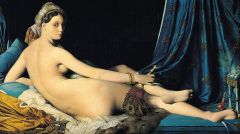
#107 La Grande Odalisque Jean-Auguste-Dominique Ingres 1814 C.E. _____________________ Content: This oil on canvas piece showcases a nude reclining female, with her body turned away from the audience, but her head turned towards the audience. She is surrounded by various pillows, fabric, fine ornaments, curtains (with peacock feather tassels) and is waring a fine headscarf and bracelet. _________________________________ Style: Neoclassicism This style strays away from Romanticism and and returns to the neoclassicism of praising classical styles like those of the Renaissance and of Titian. The incorporation of a nude subject is also a return to Greek antiquity. The polished realism also harkens back to the use of chiaroscuro and the creation of perfect skin tone. |
Context: At this time, Europe was expanding its empire into new, exotic countries and catering art to a broader audience. The subject matter of this painting was inspired by the subsequent fascination with the foreign and exotic. The "Odalisque" became a popular subject, mostly in the form of female nudes, as they were meant to be the women of Turkish harems, places where Sultans would keep their many wives. The harems were apparently very lavishly decorated with Islamic designs and the women would be brought in because of their beauty and taken care of there. This painting also includes many exotic props placed near the woman, like the colorful cloths, feathers, and pipe that is sitting at the end of the bed. In the art world, artists were beginning to find their own expression and style amidst the changes brought by revolutions, the Enlightenment and the emergence of new worlds and globalization. Artist were still, however, dominantly influenced by the English empire and its romantic fascination with exotic things. |
|
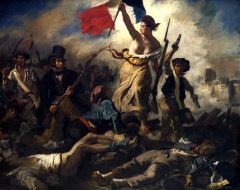
#108 Liberty Leading the People Eugène Delacroix 1830 C.E. _____________________ Content: This painting shows a revolutionary war scene with a topless women, representing "liberty", leading the people of France into battle while holding the "new" French flag aloft . The woman is followed by a young newspaper boy wielding two pistols, a well dressed gentleman, and the rest of the group follows behind. Bodies lay under the feet of the mob. _________________________________ Style: Romanticism In this piece, everything (the lines of the pistols, the angles of the bodies) is placed so it points to the Lady of Liberty. There is also an intentional use of light behind Liberty's head, which illuminates the dark composition. |
Context: This painting, more than anything else, is the French Revolution. It was painted during the revolutionary violence and uses strong symbolism, patriotism, and romanticism of what the war was about in order to further impress the ideals of the revolution onto the audience. The different appearances of the people in the group were meant to show the incorporation of all classes and all ages of people in the French revolution. The depiction of Liberty as a person, literally leading the people, is a strong symbol of what the people were fighting for and how, if they followed those ideals, they could reach an improved state in France and fly the revolutionary flag. |

